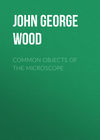Loe raamatut: «Hardy Perennials and Old Fashioned Flowers», lehekülg 25
Saxifraga Ceratophylla
Horn-leaved Saxifrage; Nat. Ord. Saxifragaceæ
For the most part, this numerous genus flowers in spring and early summer, the species now under notice being one of the late bloomers; its flowers however, like most of the Saxifrages, are small and insignificant; on the other hand, its foliage, as may be seen by the illustration (Fig. 83) is highly ornamental. In November, the grand half-globular tufts of rigid dark green foliage are delicately furnished with a whitish exudation, which, seen through a magnifying glass, resembles scales, but seen by the naked eye—and it can be clearly seen without stooping—it gives the idea of hoar frost. We have here, then, an interesting and ornamental subject, which, when grown in collections of considerable variety, proves attractive; and as even after many degrees of frost, it retains its beauty, and, I may add, its finest form, it may be confidently recommended as a suitable winter garden subject. This species proves evergreen in our climate, though a native of Spain, from which country it was imported about eighty years ago. It is sometimes called S. cornutum, a name quite applicable, and it is frequently confounded with S. pentadactylis (the Five-fingered-leaved Saxifrage), which it much resembles, from which, however, it is distinct in several respects.

Fig. 83. Saxifraga Ceratophylla.
(Leaf, one-half natural size.)
Its flowers are small, white, and numerous, produced on slender stalks in summer; they are of the general type of the flowers of the mossy section, and need not be further described. The foliage forms rigid cushions, dense, rounded, and of a dark green colour in the early season; later it becomes grey, with an exudation; the leaves are arranged in rosette form, having stout stalks, channelled or folded on the upper surface; there are three deep divisions, and others less cut; the segments are subulate, bent back and tipped with horny mucrones, whence its specific name; these horn-like points are bent under, which, together with their transparency, renders them all but invisible; they can, however, be clearly seen if brought near the eye and looked for on the under side of the foliage. The leaves are of good substance, 1in. to 2in. long, having broad stipules; the stems are exceedingly slender in the older parts, and somewhat woody, having the appearance of being dried up and dead.
On rockwork it is seen in its best form, as the slope not only shows it off better, but is conducive to a finer growth. In flat places, the dense cushions, which are 6in. or 8in. high, often rot from too much moisture. I have never seen this occur in the drier positions afforded by the slopes of a rockery. If planted between large stones it has a happy way of adapting itself to them, and few plants are more effective. It thrives equally well in soil of a loamy or vegetable character, but it seems to enjoy a little limestone, small pieces of which I place round the specimens; they also serve to hold up the lower foliage and favour the admission of air. Where alpines are grown in pots this should form one, as it makes a charming specimen; the drainage should be perfect. It also makes a capital edging plant, especially for raised beds, as then it is accommodated in the same way as on rockwork.
It may be propagated by taking the slips nearest the earth, which will often be found to have a few rootlets, but if not they will still prove the more suitable; if taken in summer and dibbled into sand, they will make good roots in a week or two, when they may be transplanted to their permanent quarters, so as to become established before winter.
Saxifraga Ciliata
Hairy-margined Saxifrage; Syn. Megasea Ciliata; Nat. Ord. Saxifragaceæ
This is a peculiar, distinct, and beautiful form of Saxifrage; there seems, however, to be some confusion in reference to its nomenclature. That it belongs to the Megasea section there can be little doubt, so that its synonym (M. ciliata) is fairly descriptive; but when it is said to be identical with S. ligulata, also of the Megasea section, the difficulty of recognising the form illustrated as such is very great indeed. It is also supposed to be a variety of S. ligulata, and though it has many important dissimilarities, it has also many affinities. So much does it differ from S. ligulata that it seems to be fully entitled to the specific honours which some authorities have given to it. It differs from S. ligulata, described by Don, in being rough and hairy on both sides of the leaves; in other respects it agrees, more especially in the colour of the flowers, which is uncommon. It may be the Megasea ciliata of Haworth, which Don refers to under S. ligulata, or it may be a distinct form of the latter, as, on the authority of Dr. Wallich, of the Botanical Gardens of Calcutta, the species has varieties. Wherever its proper place may be in its numerous genus, the name at the head hereof is a good descriptive one. It is an Indian contribution, hailing from the mountains east of Bengal. In this climate it endures our winters, though it is not one of the hardiest of its tribe. It has not long been cultivated in this country, and is rarely met with. Its distinct habit and fine flowers render it desirable, and it will with many be more so on the score of its peculiarities. A few of the latter may be mentioned here. Anthers very large, and brick-red before becoming pollenized; scapes and scape-sheaths nearly smooth, though all other foliar parts are hairy; stipules very large and fully developed whilst the leaves are in their rudimentary stage. When not in flower the plant has a strong resemblance to S. sarmentosa, which belongs to another section, but S. ciliata has features belonging to both sections. The habit, however, is more flat, and leaves more oval, and if, as has been hinted, this is a hybrid, it may not be without some relationship to that species, which is also of Asian origin. Further, on the authority of Murray, Sax. sarmentosa is identical with S. ligulata; so that, if we may suppose S. ciliata to be a distinct variety of S. ligulata, and the latter to have such affinity to S. sarmentosa that Murray puts it as identical, the chief difference between our subject and the form generally accepted as S. ligulata is accounted for, viz., the hairy and rougher surfaces of the leaves, which are traits of the well-known S. sarmentosa. If these remarks prove nothing, they may serve to show the difficulty of recognising the various forms and species of so popular a genus from reading alone, it having been so extensively treated of, and the classifications being so varied. Its study, when the species are being cultivated, is simply delightful, compared with the confusion of book study alone; and yet it is no uncommon thing, when forming a collection of Saxifrages, to receive three or four different forms from different sources under the same name, and each perhaps more or less authorised. The student by growing this genus of plants will reap other pleasures than that of identification, and in a few years time will find in his own garden (as the outcome of growing allied species) new forms springing from seed, and scattered about the beds and walks in a pleasing and suggestive manner. (See Fig. 84.)

Fig. 84. Saxifraga Ciliata.
(One-fourth natural size; (1) two-thirds natural size.)
The present subject has bell-shaped flowers, arranged in short-branched panicles, each flower ¾in. across, and sometimes, when well expanded, quite an inch; the colour is a delicate pink-tinted white; petals obovate and concave, inserted in the calyx, clawed, sometimes notched and even lobed; stamens long as petals, inserted in throat of calyx, stout, green changing to pink; anthers large and brick red when young; styles massive, joining close together, turgid, nearly long as stamens, and pale green; stigmas, simple, beardless, turning to a red colour; calyx bell-shaped, five-parted, wrinkled; segments slightly reflexed and conniving or joining; scapes 4in. to 6in. high, stout and smooth, excepting solitary hairs; bracts, leaf-like; leaves oval or cordate, 2in. to 4in. long, wrinkled, slightly waved, and toothed, conspicuously ciliated or haired on the margin, whence the specific name "ciliata." Both surfaces are also furnished with short stiff hairs, the whole leaf being stout and flatly arranged; leaf stalks short, thick, and furnished with numerous long hairs, and ample stipules, which are glabrous, but beautifully ciliated. Roots, woody, and slightly creeping on the surface. Habit of foliage reflexing, forming flat masses; smaller or supplementary scapes are sent up later than the main scape, from the midst of the stipules, bearing flowers in ones and twos. The blossom, which is effective and very beautiful, is also sweetly scented, like the hawthorn.
As already hinted, this is not one of the most hardy Saxifrages, but I have twice wintered it out on gritty beds, well raised, also on rockwork, under a warm south wall; and, as such positions can be found or made in most gardens, it would be advisable to try and establish this distinct and lovely spring bloomer. Lime and sandstone grit mixed with loam and leaf soil I find to be the best compost I have yet tried for it; in fact, until a dry situation and a little lime were given, it proved a shy bloomer. It is now quite the reverse, notwithstanding that the roots were divided during the previous autumn. Fogs and rain are its greatest plagues, owing to its hairy nature; the glass and wire shelters should be used for this most deserving subject. Propagated by division of the woody semi-creeping roots during early autumn; each division should have a crown and some roots, when they may be planted in their permanent quarters.
Flowering period, March to May.
Saxifraga (Megasea) Cordifolia
Nat. Ord. Saxifragaceæ
A first-class herbaceous perennial, grown for over a hundred years in English gardens; it comes from Siberia, and consequently, it is very hardy in this climate. The Megasea section of the Saxifraga is a very distinct genus; there are several forms with but slight distinctions in the section, but the species now under notice may be readily distinguished from its nearest known relatives, first by its extra size in all its parts, next by its wrinkled heart-shaped leaves.
The flowers are produced on stout stems nearly a foot high, a section of which will cut the size of a sixpenny piece; the rose-coloured flowers are perfectly developed before they push through the many-times over-lapped foliage; they are neatly arranged, the branching stems sometimes giving the panicle of blossom the form and also the size of a moderate bunch of grapes. Just at this stage the flowers, to be most enjoyed, should be cut before the weather spoils their delicate colour. The fine pale green calyx, which is also conspicuous by its handsome form and extra length, is far from the least important feature of this flower, especially at the above-mentioned stage. The leaves are 6in. to 10in. across.
Of the use of its flowers in a cut state, a few words may be said. The weather soon destroys their beauty, but when cut they may be preserved for fully a fortnight. On one occasion I took a blossom and placed it in a flower stand for single specimen blooms; in this instance all the other glasses held such fine roses as Baroness Rothschild, Madame Lacharme, and Edouard Morren, but so richly did it compare with these roses that it was given the place of honour—the top centre glass; this flower I should say had never seen the full light in the open. After that others pushed out of the leaves and were speedily damaged, and not fit to cut.
Flowering period, March to May.
Saxifraga Coriophylla
Nat. Ord. Saxifragaceæ
This is a rather recently discovered alpine species, very dwarf, but beautiful. The specific name would appear to be in allusion to its flowers as pink-shaped; they are very small, but the reader, by referring to the cut (Fig. 85), may form his own opinion of such likeness; however well founded or otherwise the name may be, we have in this subject a gem for the rock garden. It is a native of Albania, and belongs to that section of its extensive genus having triquetrous and obtuse leaves, or blunt three-sided foliage, as formed by a well developed keel. It is in flower in the middle of March, at the height of 2in. All its parts are of miniature dimensions, and yet when grown in a suitable position it is effective.

Fig. 85. Saxifraga Coriophylla.
(One-half natural size.)
The flowers are pure white, produced on leafy stems an inch or more high; they are few, and open in succession; petals round and overlapping; calyx large for the size of flower, and covered with down; sepals obtuse and tipped with a brown, almost red-tint; stamens short, having rather large yellow anthers, which fill the throat of the corolla. The leaves are evergreen or silvery grey, arranged in small rosettes, and ¼in. long, of good substance, rigid and smooth; their shape is obtuse, concave, and keeled; they are furnished with marginal excavations, which present themselves as dots; the habit is compact, the rosettes being crowded and forming cushioned-shaped specimens; the flowers last for a fortnight in average weather.
Between large stones in vegetable mould and grit, it both thrives and shows to advantage; it is also a charming subject for the pot culture of alpines. In company with the red-stalked and white-flowered S. Burseriana, the purple S. oppositifolia, and the many other forms of the mossy section, all, or nearly all in bloom about the same time, it offers a pleasing variety, as being distinct in every way from its contemporaries, more especially in the foliage. It is rather a slow grower, and not so readily increased as most Saxifrages; it is greatly benefited by having pebbles or small stones about the collar. These keep it moist at the roots during the growing season. If a little dry cow manure or guano is dusted amongst the stones during early summer, the results will soon be seen; such growth, however, should not be stimulated during the latter half of the year, or from its want of ripeness it will be liable to damage during winter. This practice of top dressing greatly assists the parts touching the earth to root, and so either an increased stock or larger specimens may sooner be obtained.
Flowering period, March.
Saxifraga Fortunei
Fortune's Saxifrage; Nat. Ord. Saxifragaceæ
This, as may at once be seen by a glance at Fig. 86, belongs to the lobed-leafed section. It is as yet new in English gardens, and is often grown in pots in warm glasshouses. It is, however, perfectly hardy, having stood out with me in the open for the past three years. It is nearly related to S. japonica and its varieties, but is without the stolons or runners. In this climate, with outdoor treatment, it flowers in October until cut down by frost, which sometimes happens before the flowers get well out. It has been stated not only that it is not hardy, but that its flowering period is May. With me it has proved otherwise, and others have proved it to flower naturally in October. I also observed it in bloom in the Hull Botanic Gardens on the open rockwork in November, 1882. I have no doubt that autumn is the natural season for well-established plants to flower; weaker specimens may fail to push forth ere the frost cuts down their leaves, when the dormant buds must remain sealed for the winter, but ready to develope with the return of longer and warmer days.
The flowers are arranged in panicles on scapes nearly a foot high, the panicles being 6in. long and 3in. in diameter. The petals are long and narrow, of uneven length, and notched; colour pure white. The calyx is well developed; segments oval, notched at the ends; colour, pale apple green. Stamens, long and tipped with beautifully orange-coloured anthers. The ovary is prominent, and of a pale yellow. Besides the above features, the flowers, which mostly look sideways and are quite an inch across their broadest parts, have one very long petal at the low side, and the two next are at right angles with it, less than half its size, the two upper ones being still less; the effect is both unusual and pleasing. The leaf stalks are long, stout, and of a succulent nature, semi-transparent, and slightly furnished with longish hairs; the stipules are ample, and of a bright red, which colour extends for a short length up the stalk. The leaves are kidney-shaped, 2in. to 5in. across, eight or ten lobed, toothed and reflexed; they are furnished with solitary stiff hairs, are of good substance, and a very dark green colour, but herbaceous. The habit of this species is neat and very floriferous; therefore it is a valuable plant for in or outdoor gardening; but owing to its late season of flowering outside, the blossom is liable to injury. A bell glass, however, will meet the case; it should be placed over the plant, but tilted slightly, when there are signs of frost—the flowers will amply reward such care. If the bloom can be cut clean, a good cluster will vie with many orchids for delicacy and effect.

Fig. 86. Saxifraga Fortunei.
(One-fifth natural size; 1 and 2, full size.)
I find it to do well in fat loam, and with the same kind of soil in pots, which comes in for placing in cold frames when frost threatens. I find it one of the easiest plants possible to manage—in fact, it needs no care to grow it; still, many amateurs fail to keep it, I suppose from taking it into a warm greenhouse, where it is sure to dwindle. It is readily propagated by division of the crowns, which should be done in spring.
Flowering period, October until strong frosts.
Saxifraga (Megasea) Ligulata
Nat. Ord. Saxifragaceæ
One of the large-leaved species (see Fig. 87) compared with others of the Megasea section, its leaves are strap-like, as implied by the specific name. It is sometimes called Megasea ciliata, but there is a large-leaved species, commonly called S. ciliata, which is very distinct from this one, and it is all the more important that they should not be confounded with each other, as S. ciliata is not very hardy, whilst this is perfectly so, being also one of our finest herbaceous perennials. It comes to us from Nepaul, and has not long been cultivated in this country.

Fig. 87. Saxifraga (Megasea) Ligulata.
Its flowers are produced numerously on bold stout stems 10in. high. Sometimes the flower-stem is branched. The pale but clear rosy flowers are not only showy, but very enduring, lasting several weeks. The leaves are six to ten inches long, of irregular form, but handsomely ribbed and wavy; the new growths are bright yellowish-green, and tinted from the edges with a reddish bronze, so that, during spring, besides being finely in flower, it is otherwise a pleasing plant to look upon. Moreover, it is one of the few bold kinds of plants which flower so early and therefore a most valuable subject for the spring flower-beds.
It looks well in any position, either near or back from the walks, in shrubs, or as a centre specimen for beds; it is also a plant that may be moved easily, as it carries plenty of root and earth, consequently it may be used in such designs as necessitate frequent transplantings. It is not particular as to soil or position, but in light earth, well enriched with stable manure, I have found it to thrive, so as to be equal to many of the so-called "fine foliage" plants during summer; therefore, I should say, give it rich food. To propagate it, a strong specimen with branched crowns should be selected. These branches or stems are ½in. to 1in. thick. They should be cut off with as much length as possible; if they have a bit of root, all the better; if not, it does not much matter. Let the cut end dry for a little time, take off half, or even the whole, of the largest leaves, or the action of the wind will prevent their remaining firm. When so prepared, the cuttings may be deeply planted in sandy loam, which has previously been deeply stirred. This may be done as soon as the flowers are past, and by the end of the year the cuttings should be well rooted and suitable for moving into the ornamental part of the garden.
Flowering period, March to May.















